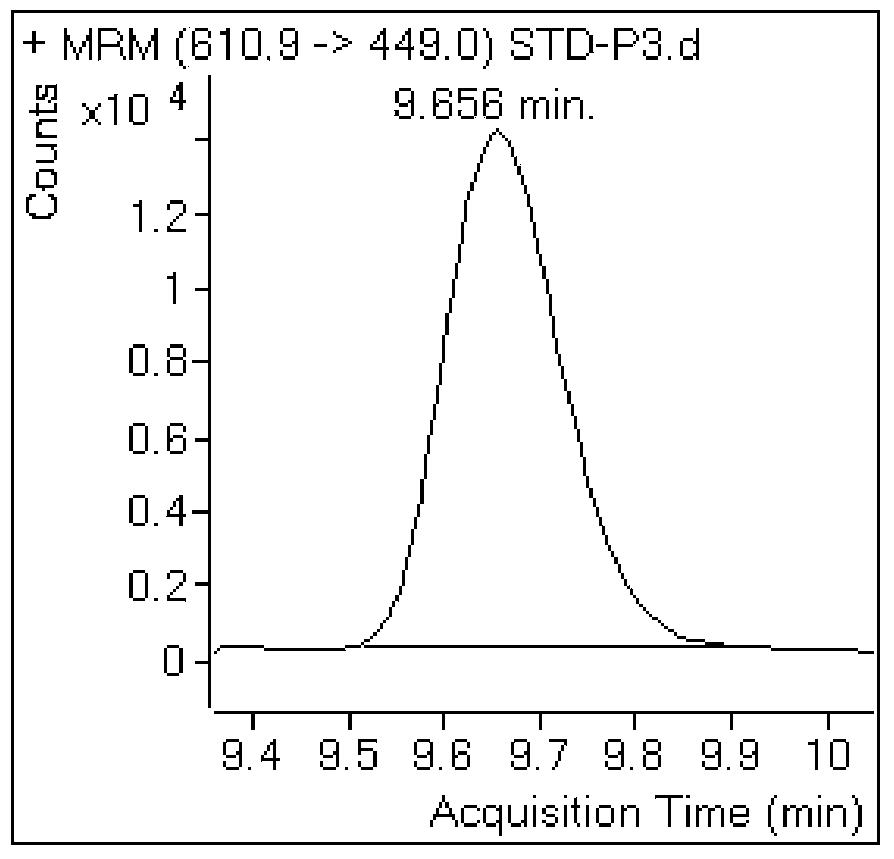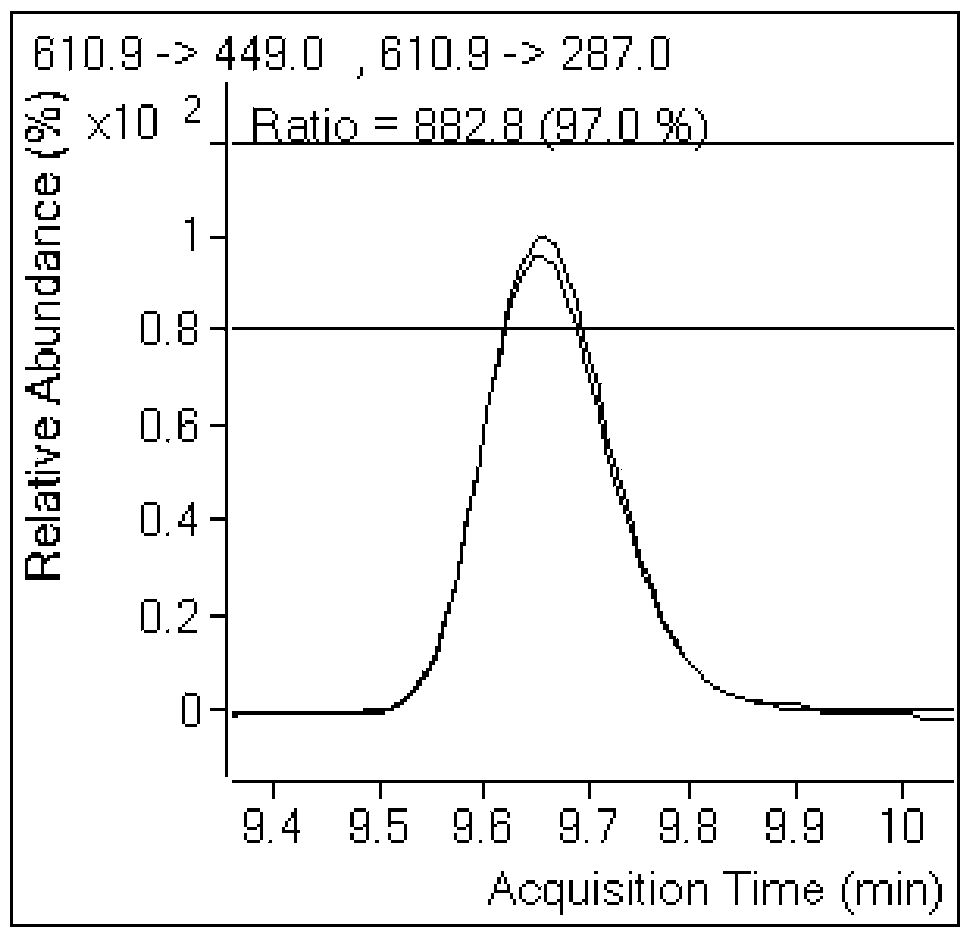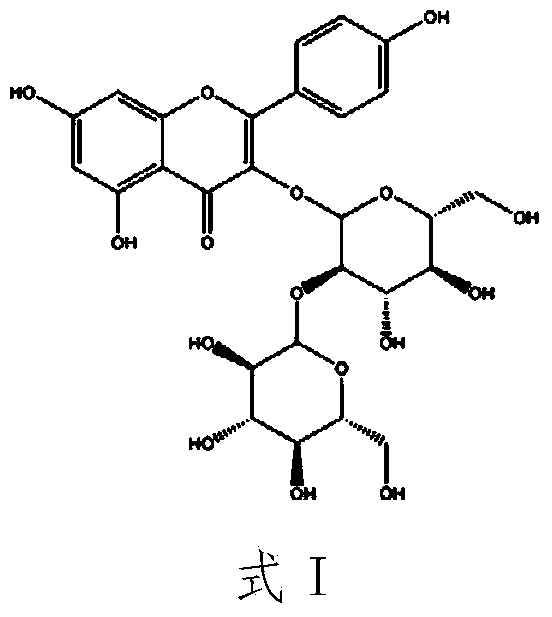Method for identifying bee pollen based on kaempferol 3-O-beta-D-glucose-(2-1)-beta-D-glucoside
A technology of glucoside and bee pollen, which is applied in the direction of measuring devices, instruments, scientific instruments, etc., can solve the problems that have not been seen in the application of kaempferol in the identification of bee pollen, achieve accurate extraction methods and instrument analysis methods, increase extraction efficiency, and improve methods simple effect
- Summary
- Abstract
- Description
- Claims
- Application Information
AI Technical Summary
Problems solved by technology
Method used
Image
Examples
Embodiment 1
[0059] 1) Preparation of standard stock solution (2.0mg / mL): Accurately weigh 50.0mg of the standard substance kaempferol 3-O-β-D-glucose-(2→1)-β-D-glucoside, and place it in a volume of 25mL In the bottle, dissolve with methanol and dilute to volume, shake well, and prepare a 2.0 mg / mL standard stock solution for future use (storage conditions: sealed, stored at -20°C, stable for 6 months).
[0060] 2) Preparation of standard working solution: Take an appropriate amount of standard stock solution in a 10mL volumetric flask, dilute to volume with methanol successively, and prepare the following series of standard working solutions: 1ng / mL, 10ng / mL, 50ng / mL, 100ng / mL, 500ng / mL and 1000ng / mL, ready for use (preservation conditions: sealed, stored in a refrigerator at 4°C for use, stable for 1 month).
[0061] 3) Bee pollen sample pretreatment method: Weigh 12 parts of evenly crushed bee pollen samples, put about 1.0 per part into the extraction pool, set the temperature at 45°C,...
Embodiment 2
[0072] 1) Preparation of standard stock solution (2.0 mg / mL): same as Example 1.
[0073] 2) Preparation of standard working solution: same as Example 1.
[0074] 3) Pretreatment method of bee pollen samples: Weigh 12 parts of evenly crushed bee pollen samples, put about 1.5g of each into the extraction pool, set the temperature at 50°C, the pressure at 25MPa, and the entrainer concentration at 78%, The flow rate of ethanol was 0.4mL / min, the extraction time was 3.8 hours, and the flow rate of carbon dioxide was 4.0L / h. The extracted product was dilute to 50 mL with ethanol. Draw part of the bee pollen sample solution from the volumetric flask and dilute it 10 times with pure water, and take 1.0 mL for analysis.
[0075] 4) Liquid chromatography-tandem mass spectrometry conditions: the same as in Example 1
[0076] 5) Determination method
[0077] Qualitative determination: with embodiment 1.
[0078] Quantitative determination: with embodiment 1.
[0079] 6) Results: The ...
Embodiment 3
[0083] 1) Preparation of standard stock solution (2.0 mg / mL): same as Example 1.
[0084] 2) Preparation of standard working solution: same as Example 1.
[0085] 3) Pretreatment method of bee pollen samples: Weigh 12 parts of evenly crushed bee pollen samples, put about 2.0 g each into the extraction pool, set the temperature at 50°C, the pressure at 40 MPa, and the entrainer concentration at 80%, The flow rate of ethanol was 0.4mL / min, the extraction time was 4 hours, and the flow rate of carbon dioxide was 2.0L / h. The extracted product was dilute to 50 mL with ethanol. Draw part of the bee pollen sample solution from the volumetric flask and dilute it 10 times with pure water, and take 1.0 mL for analysis.
[0086] 4) Liquid chromatography-tandem mass spectrometry conditions: the same as in Example 1.
[0087] 5) Determination method
[0088] Qualitative determination: with embodiment 1.
[0089] Quantitative determination: with embodiment 1.
[0090] 6) Results: The ...
PUM
| Property | Measurement | Unit |
|---|---|---|
| Particle size | aaaaa | aaaaa |
Abstract
Description
Claims
Application Information
 Login to View More
Login to View More - R&D
- Intellectual Property
- Life Sciences
- Materials
- Tech Scout
- Unparalleled Data Quality
- Higher Quality Content
- 60% Fewer Hallucinations
Browse by: Latest US Patents, China's latest patents, Technical Efficacy Thesaurus, Application Domain, Technology Topic, Popular Technical Reports.
© 2025 PatSnap. All rights reserved.Legal|Privacy policy|Modern Slavery Act Transparency Statement|Sitemap|About US| Contact US: help@patsnap.com



